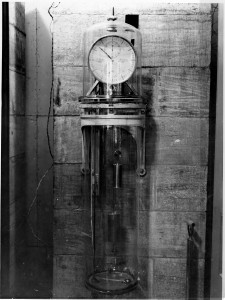From the Collection: Riefler Clock

While a telescope may be the most valuable piece of equipment found in an observatory, a close second is the clock. Through most of Dudley’s history, the type of astronomical work it was doing required precise, consistent timekeeping. Not surprisingly, Dudley has owned some of the best clocks available. Sometimes they were adventurous attempts at timekeeping, like the Polsey Clock by Moses Farmer. Other times the director played it safe by simply purchasing the most reliable clock on the market.
This is one of the latter: a clock by the Clemens Riefler Company of Munich, Germany, built in 1903. Started by Sigmund Rielfer, the company made the most accurate clocks in the world during the later 19th century until the invention of quartz timekeeping in the late 1920s. At their best, Riefler clocks could operate with a variance of only 10 milliseconds per day. The US Bureau of Standards used a Riefler clocks to set the standard time from 1904 to 1929.

This accuracy required a bit of work. Dudley’s clocks were mounted inside glass cylinders. These cylinders then had the air pumped out using a foot pump (you can see the handle of the pump in the bottom right of the photograph here.) This protected the clock from changes in atmospheric pressure, which could alter the motion of the gears enough that a few milliseconds could be gained or lost. These cylinders were fitted with an iron collar and bolted to a stone pier that was anchored in the ground. This protected the clock from vibrations.
Dudley owns two Rielfer clocks, both purchased during the years when Dudley was working with the Carnegie Institution. Dudley was the Institution’s Department of Meridian Astronomy, working to produce the most accurate star catalog to the early 20th century. This task, probably more than any other task in astronomy, require precise time. Even more, it required consistent time, as the job went on, night after night, for years.
If this clock looks familiar, it’s because it was recently part of the “Capital Region in 50 Object” exhibit at the Albany Institute of History and Art, where it sat between a giant metal butterfly from the Albany Pinebush Preserve and a gorgeous Dutch Kas from the Schenectady County Historical Society. I thank the good folks at the AIHA for inviting us into the exhibit, and also for letting us use one of their old vertical mummy display cases, which makes me feel strangely honored.
